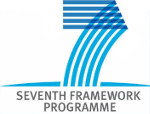Reconfigurable computing for Monte Carlo simulations: Results and prospects of the Janus project
Baity-Jesi, M. ; Baños, R.A. (Universidad de Zaragoza) ; Cruz, A. (Universidad de Zaragoza) ; Fernandez, L.A. ; Gil-Narvion, J. ; Gordillo-Guerrero, A. ; Guidetti, M. ; Iñiguez, D. ; Maiorano, A. ; Mantovani, F. ; Marinari, E. ; Martin-Mayor, V. ; Monforte-Garcia, J. (Universidad de Zaragoza) ; Sudupe, A.M. ; Navarro, D. (Universidad de Zaragoza) ; Parisi, G. ; Pivanti, M. ; Perez-Gaviro, S. ; Ricci-Tersenghi, F. ; Ruiz-Lorenzo, J. ; Schifano, S.F. ; Seoane, B. (Universidad de Zaragoza) ; Tarancon, A. (Universidad de Zaragoza) ; Tellez, P. ; Tripiccione, R. ; Yllanes, D.
Resumen: We describe Janus, a massively parallel FPGA-based computer optimized for the simulation of spin glasses, theoretical models for the behavior of glassy materials. FPGAs (as compared to GPUs or many-core processors) provide a complementary approach to massively parallel computing. In particular, our model problem is formulated in terms of binary variables, and floating-point operations can be (almost) completely avoided. The FPGA architecture allows us to run many independent threads with almost no latencies in memory access, thus updating up to 1024 spins per cycle. We describe Janus in detail and we summarize the physics results obtained in four years of operation of this machine; we discuss two types of physics applications: long simulations on very large systems (which try to mimic and provide understanding about the experimental non-equilibrium dynamics), and low-temperature equilibrium simulations using an artificial parallel tempering dynamics. The time scale of our non-equilibrium simulations spans eleven orders of magnitude (from picoseconds to a tenth of a second). On the other hand, our equilibrium simulations are unprecedented both because of the low temperatures reached and for the large systems that we have brought to equilibrium. A finite-time scaling ansatz emerges from the detailed comparison of the two sets of simulations. Janus has made it possible to perform spin-glass simulations that would take several decades on more conventional architectures. The paper ends with an assessment of the potential of possible future versions of the Janus architecture, based on state-of-the-art technology.
Idioma: Inglés
DOI: 10.1140/epjst/e2012-01636-9
Año: 2012
Publicado en: European Physical Journal-Special Topics 210, 1 (2012), 33-51
ISSN: 1951-6355
Factor impacto JCR: 1.796 (2012)
Categ. JCR: PHYSICS, MULTIDISCIPLINARY rank: 23 / 83 = 0.277 (2012) - Q2 - T1
Financiación: info:eu-repo/grantAgreement/EC/FP7/247328/EU/Critical Phenomena in Random Systems/CRIPHERASY
Financiación: info:eu-repo/grantAgreement/ES/MEC/FIS2006-08533
Financiación: info:eu-repo/grantAgreement/ES/MEC/FPA2004-02602
Financiación: info:eu-repo/grantAgreement/ES/MICINN/FIS2007-60977
Financiación: info:eu-repo/grantAgreement/ES/MICINN/FIS2009-12648
Financiación: info:eu-repo/grantAgreement/ES/MICINN/FIS2010-16587
Financiación: info:eu-repo/grantAgreement/ES/MICINN/TEC2010-19207
Tipo y forma: Artículo (PrePrint)
Área (Departamento): Área Tecnología Electrónica (Dpto. Ingeniería Electrón.Com.)
Área (Departamento): Área Ingeniería Química (Dpto. Ing.Quím.Tecnol.Med.Amb.)
Área (Departamento): Área Física Teórica (Dpto. Física Teórica)
 Derechos reservados por el editor de la revista
Derechos reservados por el editor de la revista
Exportado de SIDERAL (2025-10-17-14:12:53)
Visitas y descargas
Idioma: Inglés
DOI: 10.1140/epjst/e2012-01636-9
Año: 2012
Publicado en: European Physical Journal-Special Topics 210, 1 (2012), 33-51
ISSN: 1951-6355
Factor impacto JCR: 1.796 (2012)
Categ. JCR: PHYSICS, MULTIDISCIPLINARY rank: 23 / 83 = 0.277 (2012) - Q2 - T1
Financiación: info:eu-repo/grantAgreement/EC/FP7/247328/EU/Critical Phenomena in Random Systems/CRIPHERASY
Financiación: info:eu-repo/grantAgreement/ES/MEC/FIS2006-08533
Financiación: info:eu-repo/grantAgreement/ES/MEC/FPA2004-02602
Financiación: info:eu-repo/grantAgreement/ES/MICINN/FIS2007-60977
Financiación: info:eu-repo/grantAgreement/ES/MICINN/FIS2009-12648
Financiación: info:eu-repo/grantAgreement/ES/MICINN/FIS2010-16587
Financiación: info:eu-repo/grantAgreement/ES/MICINN/TEC2010-19207
Tipo y forma: Artículo (PrePrint)
Área (Departamento): Área Tecnología Electrónica (Dpto. Ingeniería Electrón.Com.)
Área (Departamento): Área Ingeniería Química (Dpto. Ing.Quím.Tecnol.Med.Amb.)
Área (Departamento): Área Física Teórica (Dpto. Física Teórica)
Exportado de SIDERAL (2025-10-17-14:12:53)
Enlace permanente:
Visitas y descargas
Este artículo se encuentra en las siguientes colecciones:
Artículos > Artículos por área > Tecnología Electrónica
Artículos > Artículos por área > Ingeniería Química
Artículos > Artículos por área > Física Teórica
Registro creado el 2025-04-01, última modificación el 2025-10-17
